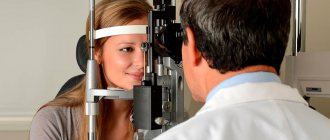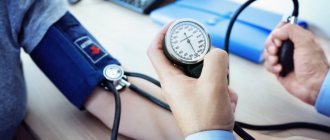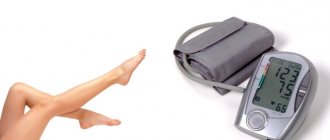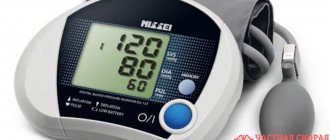When to worry about blood pressure
A slight short-term excess of normal blood pressure is typical for many during physical activity and stressful conditions. This physiological reaction of the heart and blood vessels is considered normal if the indicators return to normal within 30 minutes of rest and do not lead to a deterioration in well-being. The so-called white coat syndrome—excitement at the moment of measurement with a tonometer—also plays a role. Stress hormones contribute to a proportional increase in systolic and diastolic pressure by about 10 units. Severe fever with high body temperature also provokes an increase in blood pressure values.
If such deviations occur occasionally, without causing significant symptoms, you don’t have to worry. For young healthy people, it is enough to check the indicators once every 4-5 months. After 40 years, it is recommended to do this more often: every month and with any deterioration in physical condition.
A persistent increase in blood pressure is indicated if blood pressure levels cross the 130/90 mark regularly. And often recorded such results are a reason to suspect a chronic health disorder. It is especially important to control blood pressure for people at risk:
- overweight;
- with diagnosed heart pathologies;
- with weather sensitivity;
- with high levels of cholesterol, blood sugar;
- smoking and drinking alcohol;
- those who are over 50 years old.
What blood pressure is considered high?
Blood pressure (blood pressure, blood pressure) is the force with which blood acts on the walls of the vascular bed. The indicator is measured with a tonometer and recorded in the form of two values:
- Systolic blood pressure is “upper”. Indicates the level of pressure at the moment of active contraction of the heart - systole.
- Diastolic blood pressure is “lower”. Indicates the level of pressure at the moment of relaxation of the heart - diastole.
The “classical” normal blood pressure is considered to be 120/80 mmHg. Art. Current recommendations include an increase in blood pressure to 129/84 mmHg. Art. is also not considered a pathology. If, during several measurements, the numbers on the tonometer are within the range of 130–139/85–89 mm Hg. Art., they talk about “high normal” pressure, and exceeding these values is a clear sign of hypertension.
The mechanical reason for the increase in the force of action of blood on the vascular walls is the narrowing of the arteries, which can occur under the influence of a number of external and internal factors (Fig. 1).
Figure 1. The mechanism of increased blood pressure is vasoconstriction. Source: MedPortal
High blood pressure may not manifest itself for a long time. Vivid symptoms occur only with a sharp rise in pressure. Under such conditions, a person’s heart works “for wear and tear”: the heavier the blood passes through the vessels, the more effort the heart muscle has to put in. This leads to a constant negative impact not only on the human cardiovascular system, but also on the kidneys, brain structures, and visual analyzer.
Hypertension can only be reliably detected through systematic blood pressure measurements. However, some symptoms may suggest increased blood pressure. These include:
- headache;
- dizziness;
- disturbances of consciousness (cloudness);
- periodic tingling, moderate pain in the chest;
- increased heart rate;
- increased fatigue;
- feeling of lack of air (shortness of breath) during physical activity;
- redness of the facial skin;
- nosebleeds for no apparent reason.
Hypertension is a very common pathology. According to WHO, about 30% of the world's adult population suffers from high blood pressure, and complications of the disease (including heart attacks and strokes) lead to approximately 9 million deaths annually. At the same time, only 10% of hypertensive patients follow doctors’ recommendations and receive treatment, and about 40% are not even aware of their diagnosis.
Classification of hypertension depending on the causes
Cases of persistent high blood pressure are usually divided into two groups:
- Primary hypertension (essential hypertension). In this case, the specific cause of the development of the disease cannot be identified: the pathology develops under the influence of a complex of factors. Cases of primary forms of the disease account for 90–95% of hypertension.
- Secondary hypertension (symptomatic), when disturbances in vascular tone become a complication of the underlying disease or appear under the influence of a specific cause, accounts for 5% of all cases. With symptomatic hypertension, the cause of increased blood pressure can be identified and excluded by normalizing the values.
Such statistics do not mean that in most cases it is impossible to influence the increase in blood pressure. With the right approach, it is possible to minimize risk factors even with primary hypertension.
Symptoms and causes of high blood pressure
Pathological hypertension at the initial stage practically does not manifest itself at all or is disguised as signs of fatigue:
- Patients do not tolerate heat and stuffiness well;
- their pulse periodically increases and tachycardia occurs;
- attacks of headache occur with a feeling of pounding in the temples.
With very high tonometer readings, physical weakness, poor coordination of movements, a sharp bursting headache, visual disturbances, and shortness of breath are characteristic. Such conditions can persist for several hours and do not go away on their own, requiring urgent medical correction.
- The most common cause of high blood pressure is primary hypertension. Vascular pathology develops in a chronic form and progresses over time. Its main symptom is a proportional persistent violation of blood pressure. The first stage of the disease lasts asymptomatically; over the years, the condition without drug correction can lead to a heart attack or stroke.
- Cardiovascular pathologies. With atherosclerotic lesions of large vessels, an increase in upper systolic pressure is characteristic. In this case, the indicators on the left and right hands may differ.
- Kidney disease is another common cause of hypertension. The retention of salts and water in the body increases the total volume of fluid and the load on blood vessels. A characteristic sign is the lower indicator - diastolic pressure is usually higher, and systolic pressure may differ little from the norm. Renal hypertension occurs in older and younger people. It can be genetically determined, or develops due to functional disorders, damage or inflammation of organs.
- Severe menopause. In some women, menopause is accompanied by severe hypertension due to hormonal changes: a decrease in estrogen levels.
- Thyrotoxicosis. Disorders of the thyroid gland with an increase in hormone production causes systolic hypertension, and the lower value remains normal. The condition causes a number of characteristic symptoms: irritability, weight loss, insomnia, tremor.
- Pregnancy gestosis. A specific problem that occurs in the later stages. Stress on blood vessels is caused by swelling and hormonal changes. The pressure rises to alarming levels, which can be life-threatening.
- Side effect of taking medications. Therapy with glucocorticoid hormones, painkillers, antidepressants and other groups of drugs often causes an increase in blood pressure. Usually, at the end of the course it normalizes on its own.
In case of hypertension, there are also tumors of the adrenal glands, pituitary gland, and acute intoxication with certain chemicals.
Physiological causes of hypertension
Blood pressure is a variable indicator. In a healthy person, blood pressure numbers can fluctuate throughout the day.
There is a muscle layer in the walls of blood vessels. It contracts and relaxes easily, and therefore the pressure may rise and fall slightly. But normally, these changes are so insignificant that they do not have a negative effect on the body (they are not even always noticeable when measuring blood pressure).
The main physiological causes of increased blood pressure include:
- physical activity - this can be not only sports, but also climbing stairs, brisk walking, cleaning;
- time of day - at night the parasympathetic part of the nervous system is activated, which is responsible for relaxing the muscle layer of blood vessels and lowering blood pressure;
- psychological state - strong emotions (both negative and positive) can increase blood pressure due to the action of adrenaline;
- taking stimulants - coffee, tea, chocolate, spicy and seasoned foods and a number of other foods - can lead to a short-term increase in blood pressure.
Often, an increase in pressure occurs immediately when it is measured by a doctor. Then they talk about “white coat hypertension.”
Hypertension in adolescents
Periodic increases in blood pressure during adolescence may be normal. This is due to the fact that during this period important hormonal changes occur, which can further affect the mechanisms of blood pressure regulation. Episodes of high blood pressure occur especially often in boys: this occurs under the influence of testosterone.
However, the reasons for high numbers on the tonometer in adolescents can also be:
- overweight and obesity - in children it is important to control body weight;
- bad eating habits - large amounts of fast food, snacks, offal, animal fats, salt, sweets;
- stress - high workload at school, difficult relationships with classmates, lack of self-acceptance, fears about your future can cause nervous experiences with increased blood pressure;
- other diseases - most often in adolescence, secondary hypertension is caused by kidney pathologies, heart defects, diseases of the nervous and endocrine systems.
If high blood pressure occurs only at a doctor’s appointment, but at home the tonometer shows normal 120/80 mmHg. Art., no need to worry. Most likely, this is a manifestation of fear of doctors.
Poor nutrition can cause hypertension even at a young age. Photo: https://ru.freepik.com
High blood pressure in young people
At a young age, hypertension often occurs under the influence of other diseases (pathologies of the kidneys and renal arteries, pituitary tumors, disorders of the adrenal glands, pathologies of the reproductive system in women), but the first stages of hypertension can also develop. Recently, there has been a trend toward “rejuvenation” of hypertension: a persistent increase in blood pressure for no apparent reason is increasingly being detected in people aged 40–50 years.
Diagnosing hypertension in young people is associated with a number of problems:
- high probability of aggressive (“malignant”) forms of hypertension - rapid development of the disease, frequent hypertensive crises (increased blood pressure more than 220/120 mm Hg);
- late detection of the disease - elevated blood pressure is not accompanied by symptoms for a long time, and the frequency of visits to doctors at a young age is less than in the elderly;
- lack of preventive examinations - refusal to periodically check the basic functions of the body;
- exposure to risk factors for hypertension - young people are more susceptible to stress factors, are more likely to smoke, abuse alcohol and do not follow nutritional recommendations.
At a young age, patients do not take their health seriously enough, so even after identifying hypertension, they refuse to take medications and continue to lead their usual lifestyle. This often becomes the cause of early complications of the disease and severe pathology in the future.
Prevention of hypertension
Prevention of the disease depends on the cause of the pathology. Preventive measures should be taken by men with a hereditary predisposition to high blood pressure. If there are hypertensive patients in the family, it is recommended to start preventing the disease at the age of 20–30 years.
Basic preventive measures:
- lifestyle correction: you need to eat right, a diet for high blood pressure is recommended, you should give up junk food, include fresh fruits, vegetables, dairy products, potassium-, calcium-, magnesium-containing foods in your diet;
- giving up bad habits: alcoholic drinks and smoking should be eliminated from life;
- regular walks in the fresh air: doctors recommend walking in the fresh air every day, especially before bed;
- regular visits to a cardiologist: examination should be done at least once a year;
- measuring blood pressure at home: there should be a tonometer at home, and it is recommended to measure blood pressure 2 times a day - in the morning and in the evening;
- correction of body weight: if you are overweight, a diet is required;
- physical activity: doctors recommend doing gymnastics regularly; a light warm-up of 1-20 minutes in the morning is enough, jogging or race walking in the evening.
If you follow the recommendations for the prevention of hypertension and lead a healthy lifestyle, you can avoid the development of the disease and increased blood pressure. If the disease develops, you must visit a doctor and follow the prescribed therapy. Drug therapy to normalize blood pressure is mandatory.
High blood pressure in older people
Most often, hypertension in older people is caused by atherosclerosis - the deposition of “bad cholesterol” on the walls of blood vessels. This causes a violation of their elasticity (sclerosation) and narrowing of the arterial lumen - the main mechanism for the development of hypertension.
Older people often develop type 2 diabetes, which is accompanied by vascular complications. Chronic kidney disease can also cause secondary hypertension in older people: with age, compensatory mechanisms stop working, and narrowing of the renal vessels leads to a systemic increase in blood pressure.
Although the likelihood of increased blood pressure increases with age, in older people hypertension more often occurs in a benign form - hypertensive crises develop less frequently, and medications better “keep” pressure within normal values.
Drug therapy
Drug therapy is the main method of treating high blood pressure in men. Medications for high blood pressure are prescribed by the attending physician based on tests, diagnosis, and the root cause of the disease.
To treat high blood pressure in men, the doctor prescribes antihypertensive drugs, drugs with a sedative or diuretic effect. The most popular drugs for the treatment of hypertension:
- sartans: popular tablets that lower blood pressure for 24 hours, among them Valsartan and Losartan;
- diuretics Indapamide, Hypothiazide: diuretics remove excess water and sodium from the body, lowering blood pressure;
- angiotensin-converting enzyme inhibitors Zocardis, Capoten, Renitek normalize blood circulation and dilate blood vessels;
- blockers of slow calcium channels Amlodipine, Verapamil are prescribed to patients with disturbances in the functioning of the heart;
- other antihypertensive drugs are prescribed to normalize the functioning of the circulatory and cardiovascular systems.
When using medications, you must strictly follow the treatment regimen prescribed by your doctor. You cannot change the dosage, frequency of administration or general therapy on your own.
High blood pressure can trigger the development of a hypertensive crisis. During a hypertensive crisis, the patient requires potent drugs:
- Atenolol;
- Captopril;
- Nifedipine;
- Esmolol.
If you consult a doctor for help in time, you can avoid the development of hypertension and severe consequences of the disease. You should not self-medicate or take medications without a doctor’s prescription.
If your blood pressure is very high, you can take Nifedipine tablet before the ambulance arrives.
How to cope with an attack of hypertension?
Vivid symptoms of hypertension usually occur with a sharp rise in blood pressure - the development of a hypertensive crisis. When the pressure rises above 220/120 mmHg. Art. and/or the appearance of symptoms of a complicated crisis (severe weakness, nausea, vomiting, visual disturbances, acute headache, heart pain, impaired speech or consciousness, limitation of movements in the limbs), it is necessary to urgently call emergency help.
Emergency actions in this situation boil down to ventilating the room, maintaining bed rest, maintaining a calm environment, and taking antihypertensive drugs (Fig. 3).
Figure 3. First aid for hypertensive crisis. Source: MedPortal
When to see a doctor?
A single increase in pressure is not considered a pathology, therefore, after the first case of high numbers on the tonometer, it is necessary to measure the indicator for several more days in a row.
If blood pressure is persistently elevated or is within high normal values (130–139/85–89 mm Hg), you should consult a physician or cardiologist. The doctor will determine an action plan to identify the cause of the pathology and normalize the pressure. It is important not to delay your visit to a specialist: the sooner you start treatment, the easier it will be to control your blood pressure in the future. In the initial stages of the disease, it may be enough to reconsider your lifestyle and follow a diet. If treatment is late, lifelong medication use is inevitable.
Characteristic signs of arterial hypertension
At first, arterial hypertension does not manifest itself in any way. The disease can develop asymptomatically, so a man goes to the hospital at a late stage of the disease. Failure to go to the hospital in a timely manner leads to the development of severe complications due to hypertension, so doctors recommend recording any changes in the condition so as not to miss signs of high blood pressure.
The first symptoms of high blood pressure in men are disturbances in the functioning of the heart, a feeling of nausea, headache, but gradually the condition worsens, new signs of the disease are added.
The main symptoms of high blood pressure in men:
- pain in the heart area;
- severe headache in the temples, back of the head;
- weather dependence;
- dizziness;
- vestibular disorders;
- loss of consciousness;
- black spots before the eyes;
- heart rhythm disturbance;
- increased heart rate;
- fever;
- hyperhidrosis;
- facial hyperemia;
- cold extremities.
If these symptoms appear frequently, you should consult a doctor who will conduct a comprehensive examination, determine the degree of development of the pathology, take an anamnesis and identify pathogenesis. Based on the data obtained, the doctor will draw up a treatment plan. If you ignore the symptoms of hypertension, the condition can worsen sharply, and death is not uncommon.
A man needs to pay attention to frequent headaches
Dangerous consequences of hypertension
High blood pressure in old age and in young men is a dangerous condition that can cause severe complications. Serious pathologies develop against the background of arterial hypertension:
- impaired blood flow, decreased blood supply to the legs - intermittent claudication develops;
- high pressure readings have a bad effect on the functioning of the heart and blood vessels; due to high pressure, the heart works harder, blood circulation is impaired, a person may cough up blood, limbs begin to swell, and respiratory failure develops; in this condition, the help of a doctor is required, since the lack of therapy can cost the patient’s life;
- high blood pressure affects brain function: a man may develop acute cerebrovascular accident, hemorrhage in the retina, and the person may go blind or temporarily lose vision.
High blood pressure has a bad effect on the functioning of all internal organs and tissues. If your blood pressure increases, you should consult a doctor to get quality treatment.
Hypertension affects all organs










